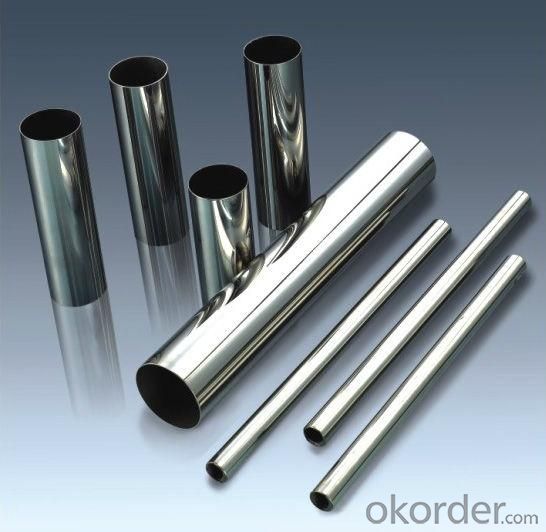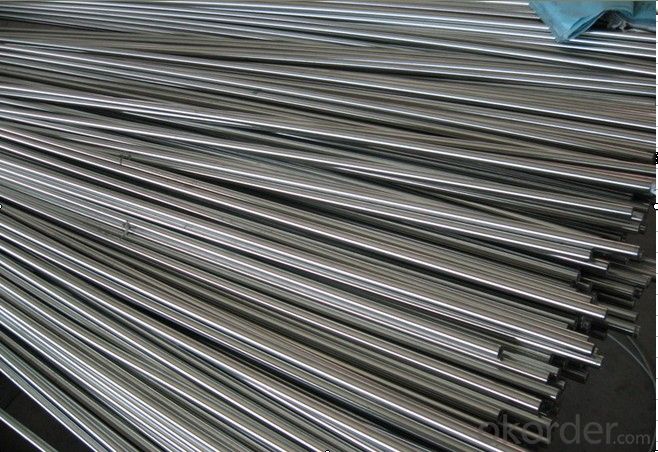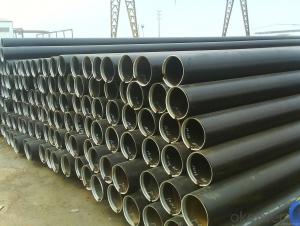ASTM53 Cold Drawn Stainless Steel Pipe Made in China
- Loading Port:
- Tianjin
- Payment Terms:
- TT OR LC
- Min Order Qty:
- 35 m.t
- Supply Capability:
- 5000 m.t/month
OKorder Service Pledge
OKorder Financial Service
You Might Also Like
Item specifice
Structure :
Seamless pipe is formed by drawing a solid billet over a piercing rod to create the hollow shell. As the manufacturing process does not include any welding, seamless pipes are perceived to be stronger and more reliable. Historically seamless pipe was regarded as withstanding pressure better than other types, and was often more easily available than welded pipe.
Main Features :
• High manufacturing accuracy
• High strength
• Small inertia resistance
• Strong heat dissipation ability
• Good visual effect
• Reasonable price
Specification:
1) Material:20#(ASTM A 106/A53 GRB.API5LGRB,GB),45#,16Mn,10#.
2) Specification range:OD:21.3-610mm,WT:6-70mm,length:6-12m or according to the requirement of clients.
3) Excutive standards:GB,ASME API5L.ASTM A 106/A53,Despite of the above standards,we can also supply seamless steel pipe with standard of DIN,JIS,and so on,and also develop new products according to the requirements of our clients!
4) Surface:black lacquered,varnish coating or galvanized.
5) Ends:Beveled or square cut,plastic capped,painted.
6) Packing:bundles wrapped with strong steel strip,seaworthy packing.
FAQ :
A. How is the quality of your products?
Our products are manufactured strictly according to national and internaional standard, and we take a test on every pipe before delivered out. If you want see our quality certifications and all kinds of testing report, please just ask us for it.
Guaranteed: If products’ quality don’t accord to discription as we give or the promise before you place order, we promise 100% refund.
B. How about price?
Yes, we are factory and be able to give you lowest price below market one, and we have a policy that “ for saving time and absolutely honest business attitude, we quote as lowest as possible for any customer, and discount can be given according to quantity”,if you like bargain and factory price is not low enough as you think, just don’t waste your time.Please trust the quotation we would give you, it is professional one.
C.Why should you chose us?
Chose happens because of quality, then price, We can give you both.Additionally, we can also offer professional products inquiry, products knowledge train(for agents), smooth goods delivery, exellent customer solution proposals.Our service formula: good quality+good price+good service=customer’s trust
SGS test is available, customer inspection before shipping is welcome, third party inspection is no problem.
Any question, pls feel free to contact us !
Product image:


Company Information:
CNBM International Corporation (CNBM International) is the most important trading platform of CNBM Group Corporation, a state-owned company under the direct supervision of State-owned Assets Supervision and Administration Commission of the State Council.
Since 2004, the trading volume of CNBM International has been doubled in 5 successive years owing to the support of superior corporations and effort of all staff. Meanwhile, we have established strategic partnerships with hundreds of domestic manufacturers and sound business relations with clients from over 120 countries. Currently, we have wholly-owned overseas subsidiaries and branches in 5 countries with a view to realize localization, which also represents an essential progress in our globalization target.
In line with the business, CNBM International launched E-business platform Okorder.com.Our goal is to transform CNBM International into the global leading brand in building materials industry within 3 to 5 years through innovation and reform, by strengthening the overall management of supply chain, developing and cultivating both domestic and overseas market, improving the procedure and information system, enhancing the ability to organize resources and to provide value-added services under a professional team and a learning organization.
- Q:Are stainless steel pipes suitable for heat exchangers?
- Yes, stainless steel pipes are suitable for heat exchangers. Stainless steel possesses excellent heat transfer properties and is resistant to corrosion and oxidation, making it an ideal material for heat exchanger applications. Its durability, high strength, and ability to withstand extreme temperatures make stainless steel pipes a reliable choice for efficient heat exchange.
- Q:How do you calculate the weight of stainless steel pipes?
- To calculate the weight of stainless steel pipes, you need to know the outer diameter, wall thickness, and length of the pipe. Using these measurements, you can apply the formula: weight = (outer diameter - wall thickness) x wall thickness x length x density of stainless steel. The density of stainless steel is typically around 7.9 grams per cubic centimeter.
- Q:Can stainless steel pipes be used for solar power systems?
- Yes, stainless steel pipes can be used for solar power systems. Stainless steel is a highly durable and corrosion-resistant material, making it a suitable choice for solar power system components. Stainless steel pipes can effectively handle the high temperatures and pressure requirements of solar thermal systems, which convert sunlight into heat energy. Additionally, stainless steel pipes are commonly used in photovoltaic (PV) systems, which convert sunlight directly into electricity. These pipes are utilized for mounting PV panels and providing structural support. Overall, stainless steel pipes are a reliable and long-lasting option for solar power systems.
- Q:What's the difference between stainless steel 304 and stainless steel 202?
- 202 stainless steel is one of the 200 series stainless steel, the national standard model is 1Cr18Mn8Ni5N. 200 series stainless steel is low nickel, high manganese stainless steel, nickel content, manganese content of about 8%, is a nickel type stainless steel.
- Q:Are stainless steel pipes suitable for fertilizer industries?
- Yes, stainless steel pipes are suitable for fertilizer industries. Stainless steel is highly resistant to corrosion, which is essential in an environment where fertilizers and other chemicals are present. Additionally, stainless steel pipes have high strength and durability, making them capable of withstanding the harsh conditions and pressures found in fertilizer production and handling processes.
- Q:What does "stainless steel pipe 201304" mean?
- 304 is a versatile stainless steel which is widely used in the manufacture of equipment and parts requiring good overall performance (corrosion resistance and formability). In order to maintain the inherent corrosion resistance of stainless steel, steel must contain more than 18% chromium, more than 8% of the nickel content. 304 stainless steel is a brand of stainless steel produced according to the ASTM standard in the United states.
- Q:How do you calculate the wall thickness for stainless steel pipes under external pressure?
- To calculate the wall thickness for stainless steel pipes under external pressure, you need to consider various factors such as the material properties, design codes, and the applied external pressure. Here is a general approach to calculating the wall thickness: 1. Determine the design pressure: The first step is to identify the external pressure that the stainless steel pipe will be subjected to. This pressure can be due to factors like fluid flow, environmental conditions, or operational requirements. 2. Determine the material properties: Stainless steel pipes have different grades, each with its own mechanical properties. Consult the material specifications to obtain the values for the yield strength (Sy) and ultimate tensile strength (Su) of the specific stainless steel grade you are working with. 3. Determine the allowable stress: The allowable stress (Sa) is the maximum stress that the material can sustain under the given conditions. It is usually provided by design codes or standards such as ASME B31.3 for process piping or ASME Section VIII for pressure vessels. 4. Calculate the design pressure thickness: Use the following formula to calculate the design pressure thickness (t): t = (P * D) / (2 * Sa) where P is the design pressure and D is the outside diameter of the stainless steel pipe. 5. Determine the corrosion allowance: Since stainless steel is prone to corrosion, it is important to consider a corrosion allowance to ensure the longevity of the pipe. The corrosion allowance is typically specified by the design codes or industry standards. 6. Calculate the final wall thickness: Add the corrosion allowance to the design pressure thickness calculated in step 4 to obtain the final wall thickness. It is important to note that this is a general approach, and specific design codes or standards may have additional requirements or factors to consider. Therefore, it is recommended to consult the relevant design codes, standards, or a qualified engineer to ensure accurate and safe calculations for your specific application.
- Q:How do stainless steel pipes differ from other types of pipes?
- There are several ways in which stainless steel pipes differ from other types of pipes. Firstly, their exceptional corrosion resistance is well-known. The presence of chromium in stainless steel creates a protective layer on the surface, preventing rust and corrosion even in harsh environments. This results in stainless steel pipes being highly durable and long-lasting compared to other pipes. Secondly, stainless steel pipes possess high strength and can withstand significant pressure and temperature variations. This is particularly important in industries where pipes are exposed to high levels of stress or extreme conditions. Stainless steel pipes can handle these conditions without compromising their structural integrity. Moreover, stainless steel pipes are highly versatile and can be used in a wide range of applications. They are commonly utilized in industries such as oil and gas, chemical processing, food and beverage, pharmaceuticals, and construction. Stainless steel pipes can handle various types of fluids, including corrosive substances, acids, and gases, making them suitable for diverse industries and applications. In addition, stainless steel pipes have excellent hygienic properties. They are easy to clean and maintain, making them ideal for applications where cleanliness is crucial, such as the food and beverage industry or medical facilities. The smooth surface of stainless steel pipes also prevents the accumulation of bacteria and other contaminants. Lastly, stainless steel pipes offer an aesthetically pleasing and modern appearance. This makes them suitable for architectural and decorative purposes, such as in building structures, handrails, or furniture. To summarize, stainless steel pipes differ from other pipes due to their corrosion resistance, high strength, versatility, hygienic properties, and aesthetic appeal. These characteristics make stainless steel pipes a popular choice in various industries and applications.
- Q:How are stainless steel pipes measured?
- Two main parameters are used to measure stainless steel pipes: outer diameter (OD) and wall thickness. The outer diameter corresponds to the pipe's outer circumference, while the wall thickness indicates the thickness of the pipe's walls. These measurements are crucial for determining the pipe's suitability for a particular application and ensuring compatibility with fittings and connectors. Stainless steel pipe dimensions are typically stated in millimeters or inches, and they may vary depending on project requirements or industry standards. Precise measurement is essential to guarantee the correct fitting and functionality of stainless steel pipes in diverse applications, including plumbing, construction, or industrial processes.
- Q:What are the common corrosion issues with stainless steel pipes?
- There are a few common corrosion issues that can occur with stainless steel pipes. One of the most common is called pitting corrosion, which is characterized by small pits or holes that form on the surface of the pipe. Pitting corrosion is often caused by exposure to chloride ions, which can come from substances like saltwater or certain types of cleaning agents. Another common corrosion issue is crevice corrosion, which occurs in the narrow gaps or crevices between the pipe and other surfaces. These gaps can trap moisture or other corrosive substances, leading to localized corrosion. Crevice corrosion is often seen in areas where the pipe is joined or in areas with poor ventilation. Stress corrosion cracking is another common problem with stainless steel pipes. It occurs when the material is exposed to a combination of tensile stress and a corrosive environment. This can cause cracks to develop in the pipe, which can lead to leaks or structural failure. Finally, galvanic corrosion is a common issue when stainless steel pipes are in contact with other metals. When two different types of metals are in contact in the presence of an electrolyte, such as water, a galvanic cell can form and cause corrosion. To prevent this, it is important to use appropriate insulation or isolation techniques when connecting stainless steel pipes to other metals. Overall, while stainless steel is known for its corrosion resistance, it is not completely immune to corrosion. Understanding these common corrosion issues and taking preventive measures can help ensure the longevity and reliability of stainless steel pipes.
1. Manufacturer Overview |
|
|---|---|
| Location | |
| Year Established | |
| Annual Output Value | |
| Main Markets | |
| Company Certifications | |
2. Manufacturer Certificates |
|
|---|---|
| a) Certification Name | |
| Range | |
| Reference | |
| Validity Period | |
3. Manufacturer Capability |
|
|---|---|
| a)Trade Capacity | |
| Nearest Port | |
| Export Percentage | |
| No.of Employees in Trade Department | |
| Language Spoken: | |
| b)Factory Information | |
| Factory Size: | |
| No. of Production Lines | |
| Contract Manufacturing | |
| Product Price Range | |
Send your message to us
ASTM53 Cold Drawn Stainless Steel Pipe Made in China
- Loading Port:
- Tianjin
- Payment Terms:
- TT OR LC
- Min Order Qty:
- 35 m.t
- Supply Capability:
- 5000 m.t/month
OKorder Service Pledge
OKorder Financial Service
Similar products
New products
Hot products
Hot Searches
Related keywords


























